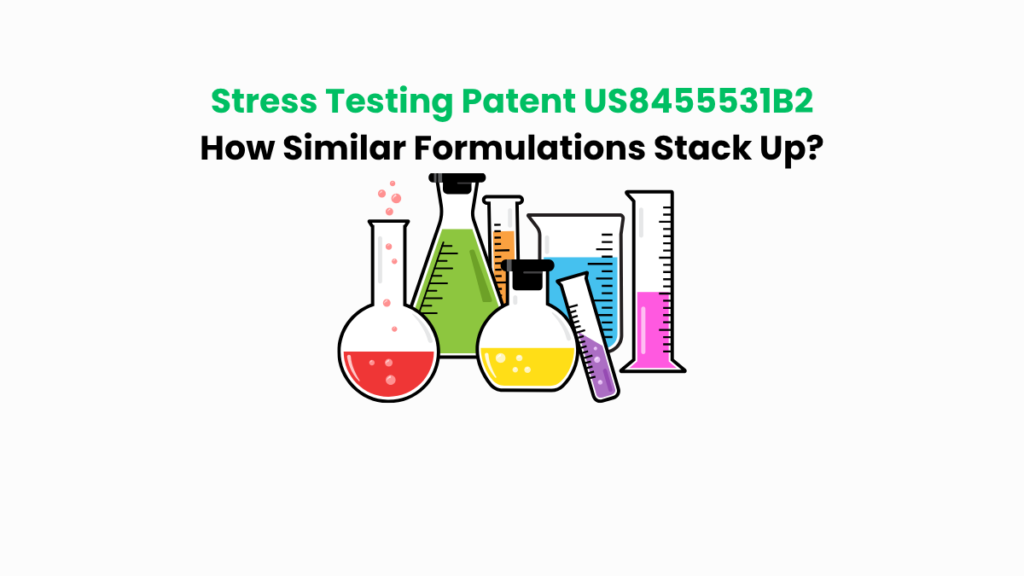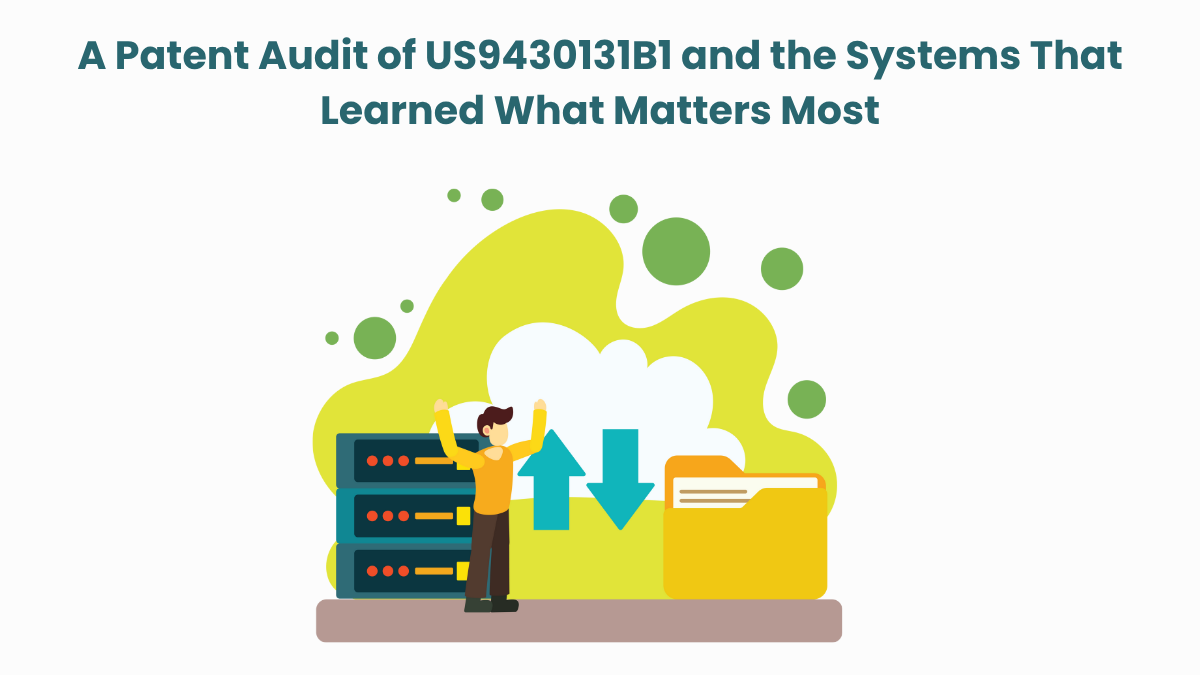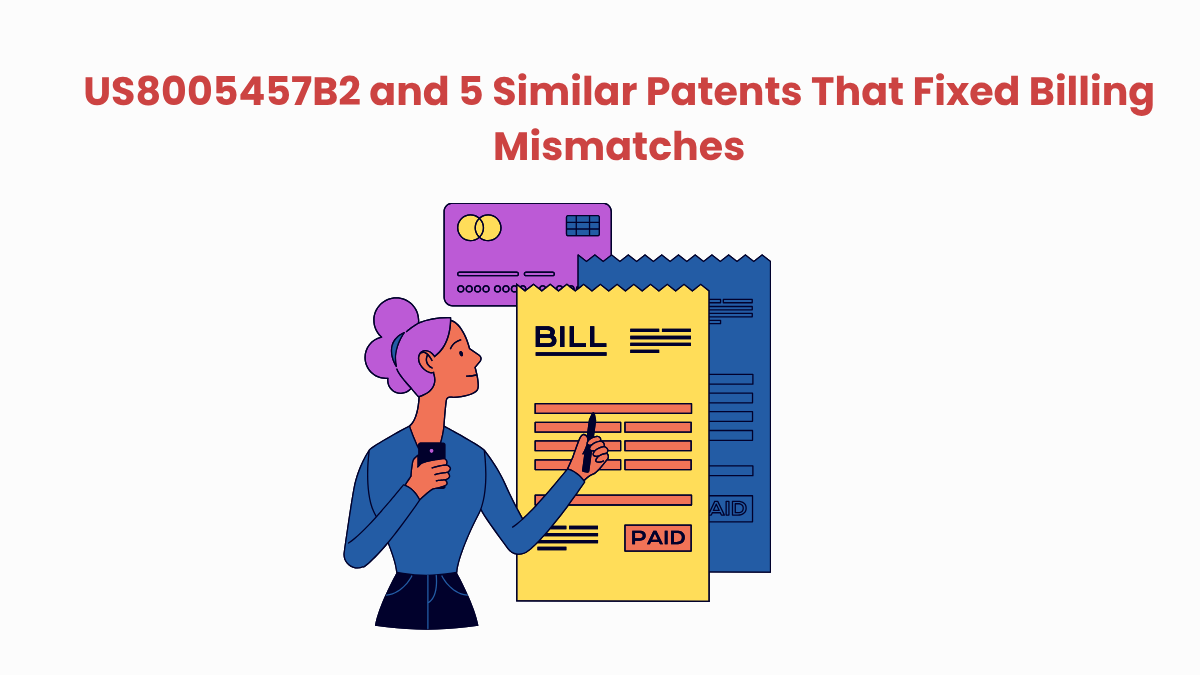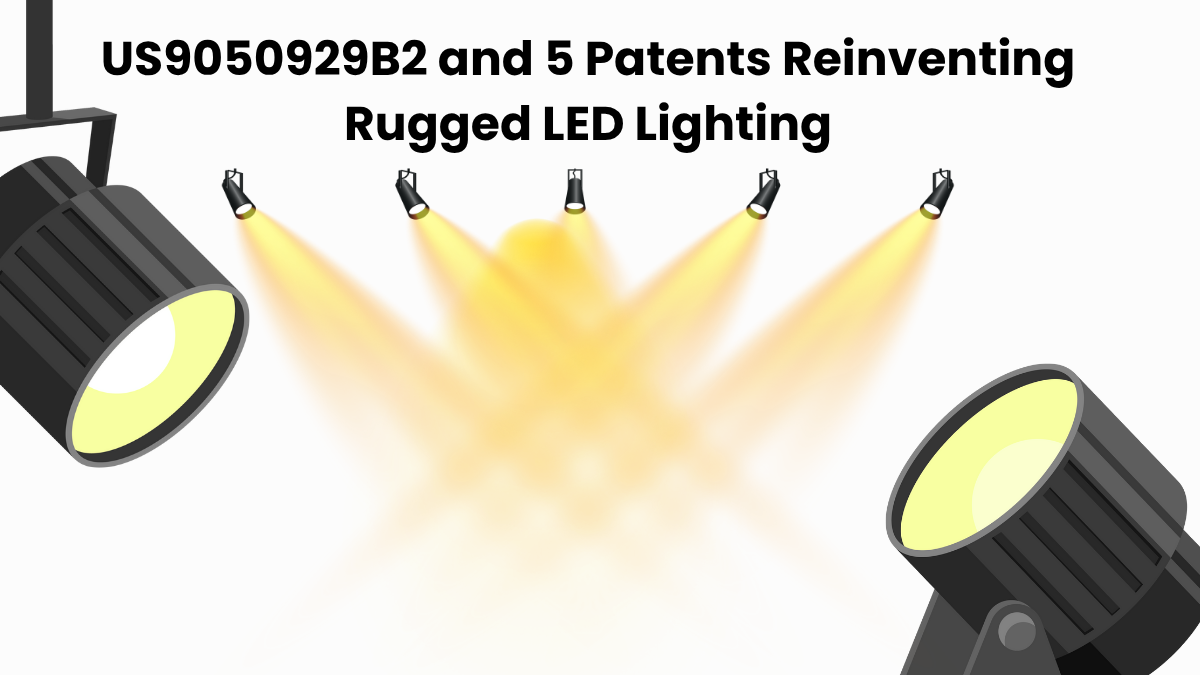Some patents make a quiet impact. Others draw focus because their core ideas appear across a wide range of products. US8455531B2 is firmly in the spotlight.
Now under scrutiny in Evolution Nutraceuticals, Inc. d/b/a Cardio Miracle v. ThermoLife International LLC, this patent outlines compositions combining specific amino acids with nitrate or nitrite compounds. These combinations are linked to better absorption and improved blood flow, concepts that are often featured in many performance and wellness supplements today.
In this article, we use the Global Patent Search (GPS) platform to trace patents with overlapping technical elements. Rather than diving into legal arguments, we’ll focus on identifying related formulations and methods that share structural or functional similarities with US8455531B2.
If you work in nutraceutical innovation, patent analysis, or ingredient-based R&D, this is a research-driven view you won’t want to miss.
Understanding Patent US8455531B2
Patent US8455531B2 discloses amino acid compositions that combine at least one nitrate, nitrite, or both with one or more specific amino acids. The invention aims to enhance the function of these amino acids in the body, particularly in terms of absorption, circulation, and solubility.
It also details methods for:
- Increasing the bioavailability of amino acids
- Improving the transport of amino acids to muscle tissue
- Enhancing the solubility of otherwise poorly soluble amino acids
- Reducing the likelihood of nitrate tolerance during supplementation
Its Four Key Features Are
#1. Nitrate/Nitrite component: Each composition includes at least one nitrate or nitrite compound.
#2. Defined amino acids: Specific amino acids such as Arginine, Citrulline, Creatine, Beta Alanine, and Leucine are included from a fixed list.
#3. Absorption improvement method: The compositions are designed to increase amino acid absorption in humans or animals.
#4. Circulatory support method: The invention includes a method to improve the delivery of amino acids through enhanced blood flow mechanisms.
This patent focuses on targeted amino acid formulations designed to improve nutrient absorption and circulation through nitrate-based chemistry. Related advances in synthetic biology are also exploring nutrient modulation through biochemical engineering.
Understanding its structure makes it possible to explore other patents that may share similar composition strategies or functional goals.
Similar Patents As US8455531B2
To explore the innovation landscape surrounding US8455531B2, we ran the patent through the Global Patent Search tool. Below is a quick glimpse of the GPS tool in action:
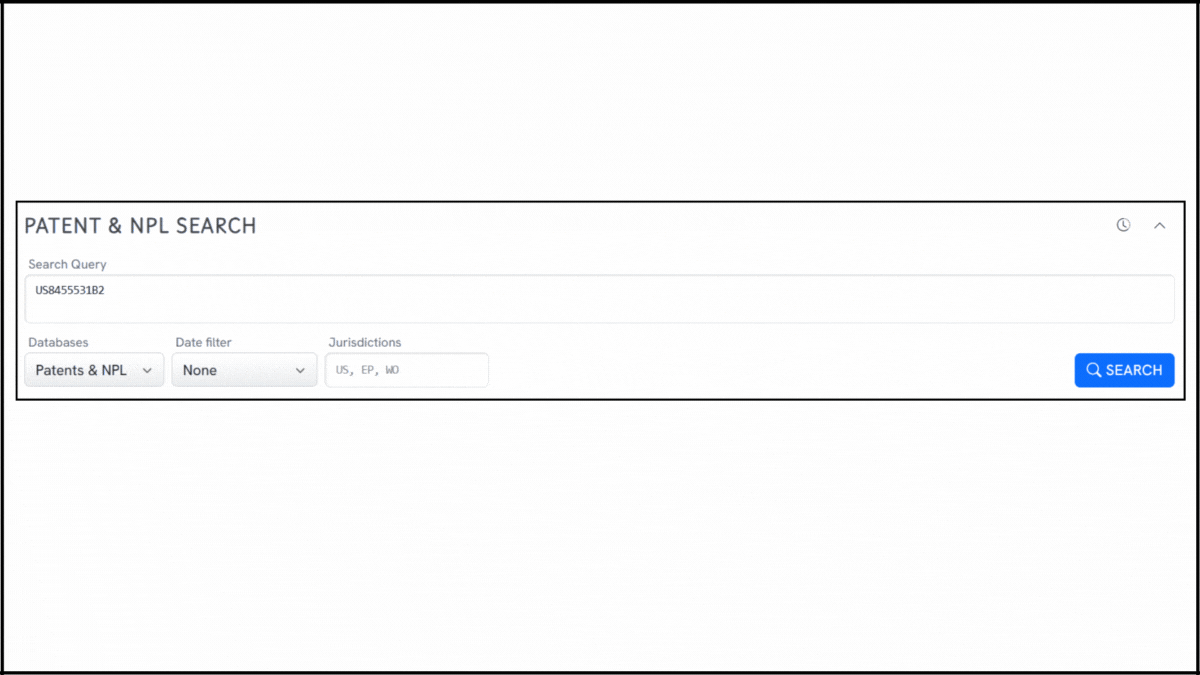
Source: Global Patent Search
This analysis surfaced a list of related patents that share technical similarities in amino acid delivery, nitrate/nitrite pairings, and methods for boosting bioavailability. Below, we highlight five of these references that reflect comparable strategies in amino acid enhancement formulations. These examples offer insight into how similar challenges have been addressed across different compositions and delivery methods.
#1. US20110313012A1
This U.S. patent, US20110313012A1, published in December 2011, outlines pharmaceutical compositions based on amino acid nitrates and nitrites. It emphasizes methods for enhancing vasodilation through compounds that combine nitrates with specific amino acids, such as arginine, Glutamine, Citrulline, and Ornithine.
Below, we have added snapshots from the GPS tool highlighting the relevant snippets from the specification for the similar patents.
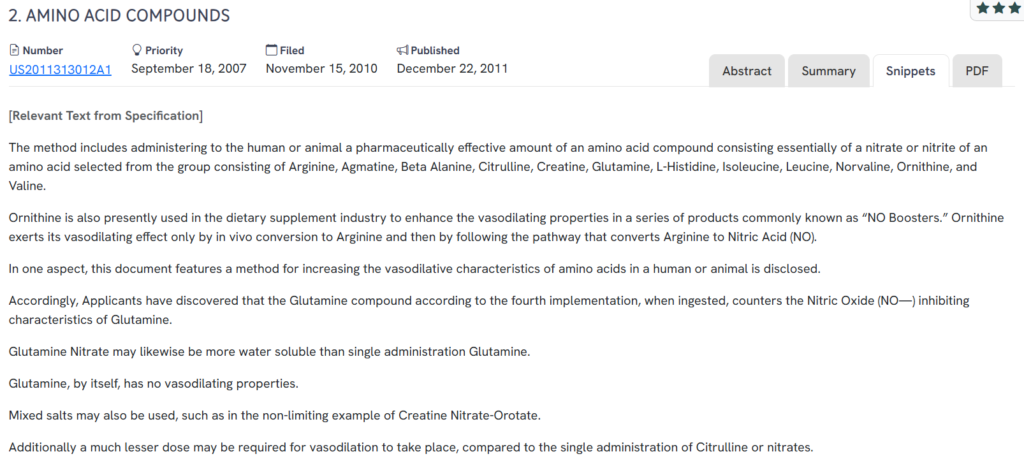
What This Patent Introduces To The Landscape
- Amino acid nitrate compounds: Focuses on forming nitrate or nitrite salts of amino acids to enhance physiological performance.
- Support for nitric oxide pathways: Includes pathways where amino acids like Ornithine convert into Arginine, increasing nitric oxide levels.
- Improved solubility and lower dosing: Notes that compounds such as Glutamine Nitrate are more water-soluble and may require smaller doses to be effective.
- Use of mixed salts: Mentions non-limiting examples such as Creatine Nitrate-Orotate to improve efficacy and stability.
How It Connects To US8455531B2
- Both patents describe amino acid compositions paired with nitrates or nitrites for enhanced absorption and circulation.
- Each focuses on physiological benefits tied to nitric oxide production, particularly vasodilation.
- Both mention formulation strategies involving mixed salts and solubility enhancement.
Why This Matters
This reference helps map the broader domain of nitrate-enhanced amino acid delivery. It shows how researchers have explored compound structures and mixed salt strategies to address solubility and bioavailability, key concerns also addressed by US8455531B2.
#2. US8569368B2
This U.S. patent, US8569368B2, published in October 2013, outlines pharmaceutical compositions made from nitrate or nitrite salts of amino acids. The method focuses on enhancing blood flow and nutrient absorption through specific compound pairings involving amino acids such as Glycine, Lysine, Methionine, and Taurine.
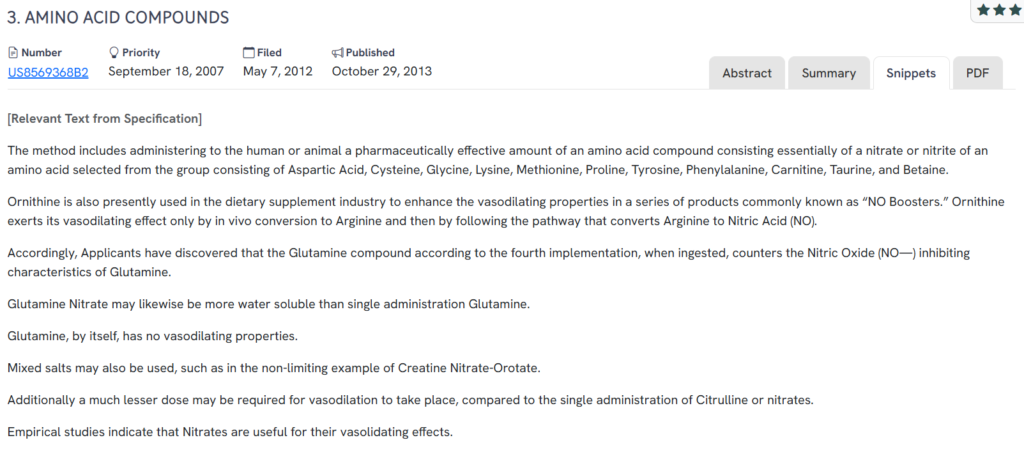
What This Patent Introduces To The Landscape
- Extended amino acid range: Covers compounds formed with additional amino acids like Carnitine, Taurine, and Betaine.
- Mechanisms supporting vasodilation: Emphasizes how specific compounds enhance nitric oxide pathways and blood flow.
- Water solubility improvements: Suggests nitrate formulations like Glutamine Nitrate improve solubility versus single-ingredient use.
- Mixed salt formulations: Describes multi-functional blends such as Creatine Nitrate-Orotate for improved utility.
- Lower dosing potential: Indicates smaller amounts of these formulations may be adequate compared to standalone amino acids.
How It Connects To US8455531B2
- Both patents disclose nitrate/nitrite amino acid compounds aimed at improving absorption and circulation.
- Each discusses how combining amino acids with nitrates enhances nitric oxide production for performance benefits.
- Both highlight solubility and formulation challenges in amino acid delivery, proposing compound-based solutions.
Why This Matters
This patent adds depth to the category of amino acid-nitrate formulations by extending the compound library and offering new delivery mechanisms. It reinforces the shared goal of optimizing absorption and physiological response, central themes also found in US8455531B2.
#3. US5891459A
This U.S. patent, US5891459A, published in April 1999, describes methods for improving vascular function by increasing nitric oxide (NO) production through the administration of amino acids like L-Arginine and L-Lysine. It also discusses ways to enhance the bioavailability and stability of these amino acids in various delivery forms.
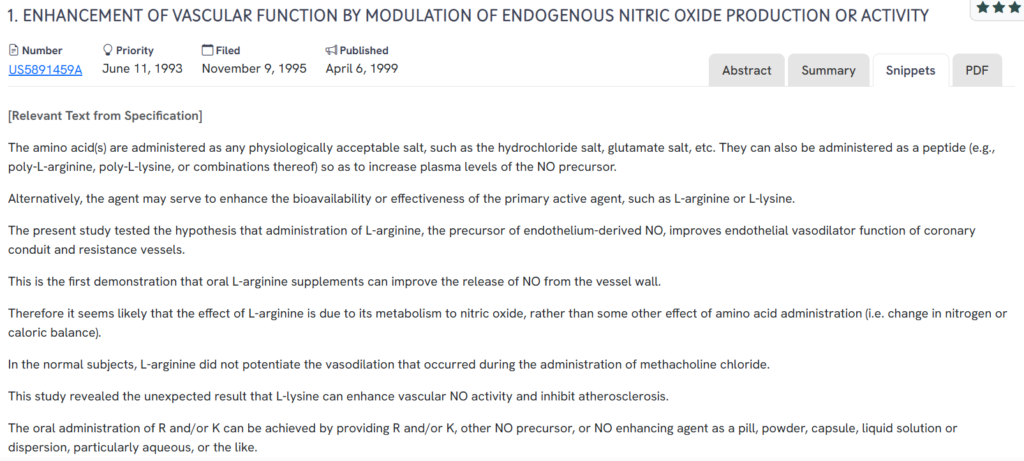
What This Patent Introduces To The Landscape
- Amino acid-based NO enhancement: Focuses on L-Arginine and L-Lysine as nitric oxide precursors for improved vascular function.
- Peptide and salt-based delivery: Proposes the use of peptides (e.g., poly-L-arginine) and various salt forms to improve bioavailability.
- NO-protective additives: Suggests adding antioxidants like Vitamin C, CoQ10, or glutathione to preserve nitric oxide activity.
- Oral and intravenous formats: Covers flexible delivery methods, including pills, powders, and aqueous solutions.
- Dual-function amino acid combinations: Explores synergistic roles of R (arginine) and K (lysine) in vascular support.
How It Connects To US8455531B2
- Both patents focus on enhancing the physiological role of amino acids to support nitric oxide pathways.
- Each explores improved delivery mechanisms to increase bioavailability and effectiveness.
- Both incorporate strategies for combining ingredients to optimize vascular benefits.
Why This Matters
This early work laid the foundational concepts around amino acid supplementation for vascular health. Its emphasis on nitric oxide enhancement and amino acid formulations echoes key elements in US8455531B2, helping to trace the evolution of composition strategies in this space.
#4. DE102004034573A1
This German patent application, DE102004034573A1, published in February 2006, describes a composition for treating vascular and metabolic diseases using a combination of amino acids: L-Arginine or Ornithine, L-Lysine, L-Carnitine, and L-Cysteine, dissolved in an isotonic sodium chloride solution.

What This Patent Introduces To The Landscape
- Multi-amino acid therapeutic blend: Combines several amino acids known for metabolic and vascular support.
- Focus on vascular health: Targets pulmonary and coronary vascular conditions through amino acid-driven mechanisms.
- Isotonic sodium chloride as a carrier: Utilizes a stable saline solution to improve delivery and absorption.
- Functional interchangeability: Arginine and Ornithine are used interchangeably to activate nitric oxide pathways.
- Application to metabolic disease: Extends use of the formulation beyond vascular health to include metabolic regulation.
How It Connects To US8455531B2
- Both patents use amino acid combinations to enhance vascular outcomes.
- Each explores formulation strategies aimed at improving delivery and bioavailability.
- Both emphasize Arginine and Ornithine as central ingredients tied to nitric oxide activity.
Why This Matters
This composition shows how targeted amino acid combinations have been used in clinical formulations to support vascular and metabolic health. Its use of core ingredients like Arginine and Cysteine reflects similar functional goals found in US8455531B2, reinforcing shared approaches to amino acid-based therapy.
#5. US10435356B1
This U.S. patent, US10435356B1, published in October 2019, discloses amino acid compositions formed by mixing amino acids with independent sources of nitrates or nitrites. The goal is to improve absorption, water solubility, and nitric oxide-related effects while also preventing nitrate tolerance.
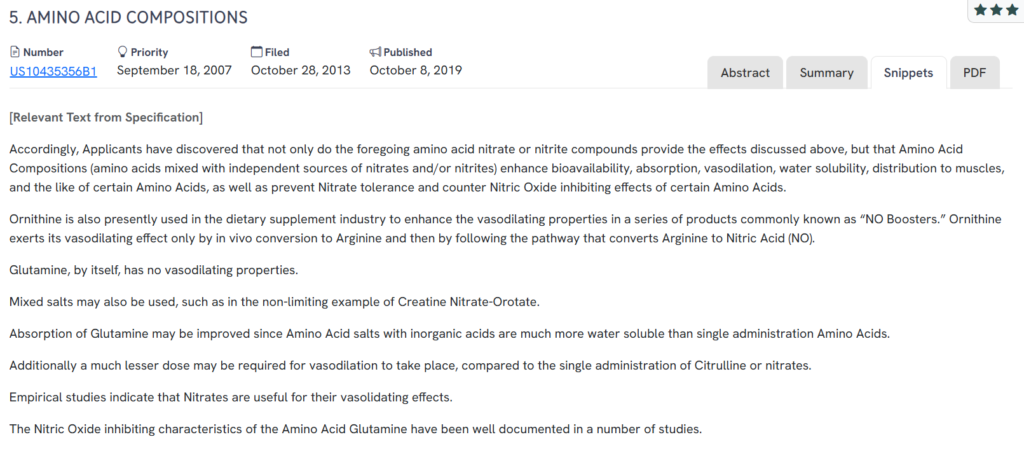
What This Patent Introduces To The Landscape
- Amino acid + nitrate compositions: Uses independent nitrate or nitrite sources mixed with amino acids to enhance effectiveness.
- Improved delivery metrics: Aims to boost absorption, vasodilation, muscle distribution, and oxygen transport.
- Solubility-focused formulation: Highlights how nitrate salts (e.g., Glutamine Nitrate) increase solubility compared to single amino acid use.
- Mechanism-based ingredient selection: Includes amino acids like Ornithine that rely on in vivo conversion to promote nitric oxide production.
- Mixed salt strategies: Features multi-functional compounds like Creatine Nitrate-Orotate and Histidine Dinitrate/Trinitrate.
How It Connects To US8455531B2
- Both patents focus on combining nitrates with amino acids to improve nutrient absorption and vasodilation.
- Each discloses compositions that include amino acids from a defined list paired with nitrate sources.
- Both emphasize strategies for countering nitrate tolerance and enhancing nitric oxide delivery mechanisms.
Why This Matters
This patent demonstrates an advanced approach to nitrate-enhanced amino acid compositions, offering flexible mixing strategies and enhanced solubility. It reflects ongoing innovation in delivery science, directly aligned with the goals and structure outlined in US8455531B2.
Note: Absorption isn’t just chemistry; it’s physical design. US9326945B2 improves apixaban uptake with crystalline particle-size control, dry-granulation, and SLS wetting to meet rapid dissolution. This parallels nutrient-absorption tactics with a small-molecule twist.
How To Find Related Patents Using Global Patent Search

Understanding the broader patent landscape is crucial when working with amino acid formulations, enhancing bioavailability, or modulating nitric oxide. The Global Patent Search tool streamlines this process, enabling users to identify compositions that employ similar strategies in nutrient delivery and vascular support.
1. Enter the patent number into GPS: Start by entering a patent number like US8455531B2 into the GPS tool. The platform converts it into a smart query, which you can refine using keywords like nitrate compounds, bioavailability, or vasodilation.

2. Explore conceptual snippets: Instead of comparing features claim-by-claim, GPS now offers curated text snippets. These highlight how other compositions improve solubility, manage nitric oxide pathways, or combine amino acids with functional additives.
3. Identify related inventions: The tool surfaces patents that tackle nutrient delivery, nitric oxide enhancement, and circulatory performance, showing how others have approached similar physiological goals.
4. Compare compositions, not legal claims: Rather than focusing on formal claim language, GPS aligns systems by their formulation behavior. This helps users find functional overlap without getting lost in legal frameworks.
5. Accelerate cross-domain insights: Whether you’re innovating in nutraceuticals, sports science, or clinical nutrition, GPS lets you connect with technologies across domains that may otherwise remain hidden.
With this approach, Global Patent Search gives formulators, analysts, and R&D teams a structured, insight-driven way to explore related compositions and strengthen their development strategies.
Disclaimer: The information provided in this article is for informational purposes only and should not be considered legal advice. The related patent references mentioned are preliminary results from the Global Patent Search tool and do not guarantee legal significance. For a comprehensive related patent analysis, we recommend conducting a detailed search using GPS or consulting a patent attorney.

